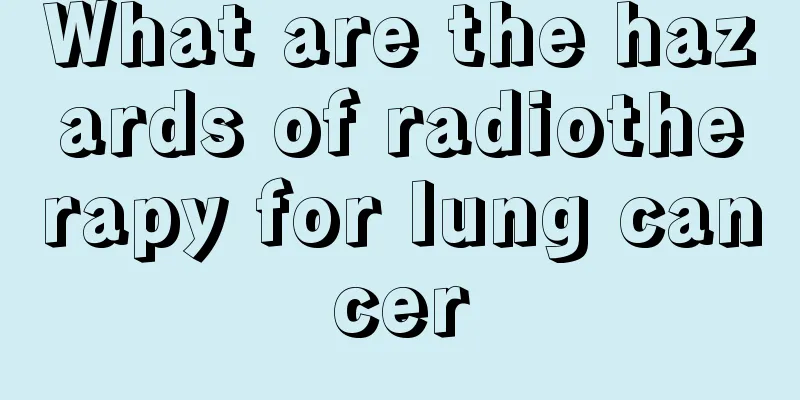What are the hazards of radiotherapy for lung cancer

|
For lung cancer patients, the side effects of radiotherapy mainly include radiation esophageal injury, radiation airway injury, radiation lung injury, heart injury and radiation spinal cord disease. During this period, you can eat a cool and non-irritating diet and avoid coarse, hard and irritating foods. During the treatment, your appetite may decrease. At this time, you should eat a light, delicious, easy-to-digest, nutritious diet, especially a high-protein, high-vitamin diet. Radiotherapy has become one of the main means of treating lung cancer, but radiation damages normal cells while destroying or eliminating cancer cells, which is the side effect of radiotherapy. The side effects caused by radiotherapy are usually divided into two types: acute and chronic. Acute reactions occur shortly after treatment and usually disappear completely within a few weeks after treatment stops; chronic reactions may take months or years to gradually appear, but are usually permanent. For lung cancer patients, the side effects of radiotherapy mainly include radiation esophageal injury, radiation airway injury, radiation lung injury, heart injury and radiation myelopathy. If the above side effects occur during radiotherapy, do not easily change, reduce or interrupt the treatment, because this will reduce the effectiveness of the treatment. Most side effects will gradually disappear after the end of radiotherapy. If the patient's reaction is particularly severe, he should report it to the doctor in time, and the doctor will give symptomatic treatment according to the symptoms. Ensure a nutritious and proper diet If nutrition cannot be guaranteed, insufficient food intake can cause hematopoiesis. In particular, about 2 weeks of treatment will cause edema of the esophageal mucosa, which may cause symptoms such as difficulty in swallowing and even pain, affecting eating. During this period, you can eat a cool and non-irritating diet, and avoid coarse, hard and irritating foods; during the treatment process, your appetite may decrease. At this time, you should eat a light, delicious, easy-to-digest, and nutritious diet, especially a high-protein, high-vitamin diet. The temperature of the meal should not be too hot, the meat should be chopped finely, and if you can't swallow vegetables or fruits, you can squeeze them into juice and drink them, and you can eat ice cubes and a small amount of cold drinks, such as yogurt. For those with dry mouth, sore throat, and severe esophagitis, you can use Chinese herbal medicine cassia and raw licorice to boil water as tea before meals and then eat, and the pain will be significantly relieved. In short, during radiotherapy for lung cancer patients, you can eat less and more meals, mainly soups, soft and light foods, and try to eat more. Prevent colds and have regular checkups Since lung cancer radiotherapy requires patients to fully expose their chests, and the temperature of the treatment room is adjusted according to the radiotherapy equipment, the temperature is relatively low, and patients are prone to catching cold. Patients can prepare two cotton sleeves with extended shoulders. During treatment, put both hands into the sleeves, and the extended shoulder part covers the shoulders and neck, which can keep warm without affecting the overall treatment position. During radiotherapy and within half a year after radiotherapy, you should prevent colds and avoid going to crowded areas. The first follow-up after radiotherapy is generally conducted one month after the completion of treatment, followed by a follow-up every three months, and after two years, a follow-up every six months. Which lung cancer patients need radiotherapy? Lung cancer is divided into small cell lung cancer and non-small cell lung cancer. For patients with early stage non-small cell lung cancer, i.e. stage 1 or 2, who are eligible for surgery, we still consider surgical treatment first if we treat them in a standardized manner. However, we also consider that lung cancer is a disease of the elderly. Although many elderly patients have early stage lung cancer, they may have some medical diseases, including hypertension, heart disease, cardiovascular and cerebrovascular diseases, or chronic lung disease, pulmonary insufficiency, etc. In particular, it is very common for lung cancer patients to have COPD. Such patients cannot tolerate surgery, so radiotherapy is the preferred treatment mode for early stage lung cancer. How effective is radiation therapy? Research in recent years has shown that radiotherapy is still very effective in treating early non-small cell lung cancer. Through the advanced treatment technology we are using now, three-dimensional conformal radiotherapy, also called image-guided radiotherapy, or X-knife or CyberKnife, the cure rate of early non-small cell lung cancer is constantly improving, and its cure rate is close to and comparable to that of surgery, according to the summary of previous data. Therefore, everyone has proposed that those who cannot tolerate surgery can achieve such good results through radiotherapy, so can they also consider early radiotherapy? In fact, international research is currently being conducted in this area, and early patients who can undergo surgery are comparing the differences between radiotherapy and surgery. Therefore, under the current circumstances, radiotherapy should be considered first for patients who cannot undergo surgery in the early stage. This is for the early stage. Of course, for patients with locally advanced disease, the so-called locally advanced stage refers to the lesions in the chest cavity or metastasis in the lungs and mediastinal lymph nodes. The current standard of treatment for this part of patients is called synchronous chemoradiotherapy. In fact, only about 2/3 of the patients in our clinic can really tolerate synchronous chemoradiotherapy, that is, 60 to 70 percent of the patients can tolerate synchronous chemoradiotherapy. There are also about 30% of patients who cannot tolerate synchronous chemoradiotherapy because of their physical conditions. The intensity of radiotherapy and chemotherapy at the same time is too high. In this case, the two may be separated or chemotherapy is done first and then radiotherapy, or radiotherapy is done first and then chemotherapy. This is for locally advanced patients. For patients with more advanced stage IV and metastasis, the reasonable combination of chemotherapy, radiotherapy and targeted therapy can improve the control of the disease, relieve pain, and play an important role in improving the quality of life. |
<<: Important risk factors for lung cancer
>>: What are the dangers of lung cancer metastasis
Recommend
What kind of tea is oolong tea?
Oolong tea is the representative of Chinese tea. ...
Fig leaf tea poisoning
In our daily lives, many external factors may aff...
What's going on with the ears ringing
Many people have experienced ringing in their ear...
What is diaphragmatic spasm?
I believe many friends have not heard of what dia...
Can people with thalassemia drink milk?
Thalassemia is relatively rare and is also a cong...
How long after teeth cleaning can I eat
Many people become afraid to eat right after they...
Treatment methods and daily care for burn scars
Scars are marks on human skin that are difficult ...
Early symptoms of uterine cancer
Early symptoms of uterine cancer: The early sympt...
How to clean tea stains from a thermos cup?
In daily life, many people like to drink tea. Dif...
Can bananas be left in the sun to ripen?
Bananas are a very common fruit in our daily life...
Can activated carbon absorb formaldehyde?
Formaldehyde is a gas that people are very afraid...
What is the fastest way to replenish platelets
I believe everyone has learned about platelets in...
What are the complications of advanced cervical cancer?
There are often no obvious symptoms in the early ...
Is melanoma dangerous?
Melanoma is a highly malignant skin cancer that n...
Knowing the symptoms of uterine cancer can help detect the patient's condition as early as possible
At present, with the increasing number of patient...









